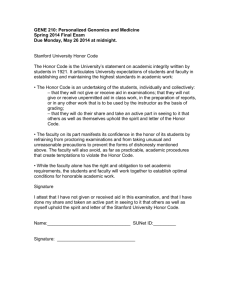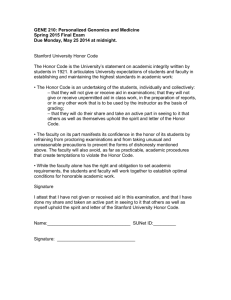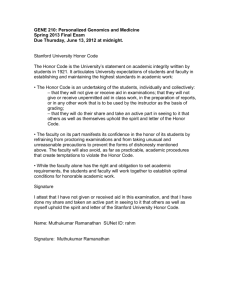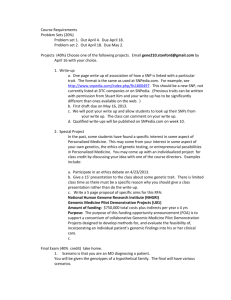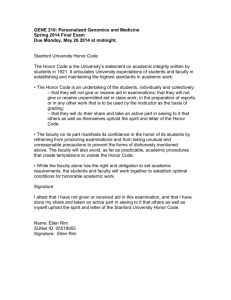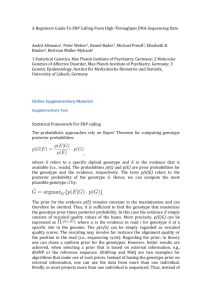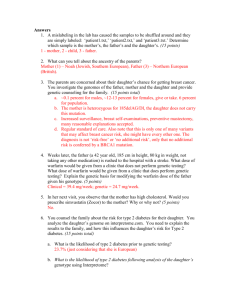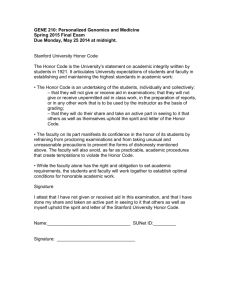Matthew_Sigurdson_Final
advertisement
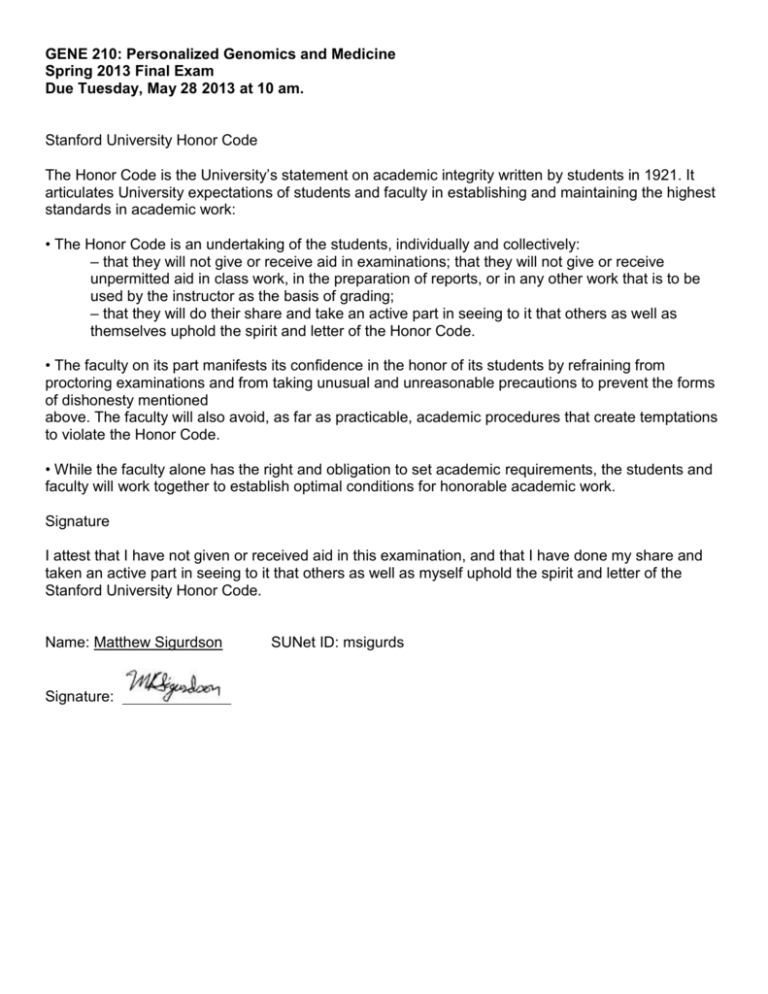
GENE 210: Personalized Genomics and Medicine Spring 2013 Final Exam Due Tuesday, May 28 2013 at 10 am. Stanford University Honor Code The Honor Code is the University’s statement on academic integrity written by students in 1921. It articulates University expectations of students and faculty in establishing and maintaining the highest standards in academic work: • The Honor Code is an undertaking of the students, individually and collectively: – that they will not give or receive aid in examinations; that they will not give or receive unpermitted aid in class work, in the preparation of reports, or in any other work that is to be used by the instructor as the basis of grading; – that they will do their share and take an active part in seeing to it that others as well as themselves uphold the spirit and letter of the Honor Code. • The faculty on its part manifests its confidence in the honor of its students by refraining from proctoring examinations and from taking unusual and unreasonable precautions to prevent the forms of dishonesty mentioned above. The faculty will also avoid, as far as practicable, academic procedures that create temptations to violate the Honor Code. • While the faculty alone has the right and obligation to set academic requirements, the students and faculty will work together to establish optimal conditions for honorable academic work. Signature I attest that I have not given or received aid in this examination, and that I have done my share and taken an active part in seeing to it that others as well as myself uphold the spirit and letter of the Stanford University Honor Code. Name: Matthew Sigurdson Signature: SUNet ID: msigurds Some questions may have multiple reasonable answers: if you are unsure, provide a justification based in genetics and cite your sources (SNPedia is fine, journals are better); as long as the justification is sound, you will receive full credit. If you are unsure which SNP(s) are associated with a trait, you may consult any reference you like. A family of 3 (mother/father/daughter) has come to you to find out what they can learn from their genotypes. The parents were both adopted, so they do not know any of their family history. You have sent their DNA to LabCorp, which ran their genotypes on a custom 1M OmniQuad array, and they’ve returned the results at: http://www.stanford.edu/class/gene210/files/final/final_patients.zip (X points) 1. A mislabeling in the lab has caused the samples to be shuffled around and they are simply labeled: ‘patient1.txt,’ ‘patient2.txt,’ and ‘patient3.txt.’ Determine which sample is the mother’s, the father’s and the daughter’s. (15 points) The parents are patients 1 and 3. (See for example rs715643: patient 1 CC, patient 3 TT, patient 2 CT allows only one possibility.) - This means the daughter is patient 2. By checking for the presence of a Y chromosome, the mother is patient 1 and the father is patient 3. 2. What can you tell about the ancestry of the parents? (15 points) Both are European (CEU). - Using PCA with POPRES:European, patient 1 is probably from southern Europe and patient 3 is probably from western Europe. 3. The parents are concerned about their daughter’s chance for getting breast cancer. You investigate the genomes of the father, mother and the daughter and provide genetic counseling for the family. (15 points total) A. What is the lifetime risk for breast cancer for the overall population of Europeans? Cancer Research UK measured the United Kingdom lifetime risk for breast cancer as1/8 (12.5%) for women and 1/868 (0.12%) for men, as of 2010. Although I didn’t find any sources specifically discussing the CEU population, a measurement of a European country is likely a good approximation. (http://www.cancerresearchuk.org/cancer-info/cancerstats/types/breast/incidence/uk-breast-cancerincidence-statistics) The SNPedia page cited in part B gives a lifetime risk of 13% as well. B. Does the genotype of the mother or daughter (at rs77944974) alter their risk of breast cancer? Explain briefly, providing data on the most important risk alleles and their effect on risk for breast cancer. This is a breast-cancer associated two-nucleotide indel in the BRCA1 gene, also called 185delAG, which increases lifetime risk for to ~81% (See SNPedia: I4000377(D;I) ). The mother is heterozygous (DI) and has this increased risk, while the daughter is II and thus does not have an increased risk. C. Briefly outline what advice you would give to the mother about her risk for breast cancer, based on your analysis? I would prefer to refer her to a genetic counselor rather than answering myself. However, if she wanted me to offer my advice, I would recommend regular checkups and/or a preventative double mastectomy. Of course, any irreversible steps should first involve consultation with an appropriate physician. D. Briefly outline what advice you would give to the daughter about her risk for breast cancer, based on your analysis? Again, I would refer her and her mother to a genetic counselor if possible. However, my advice would be that her risk of breast cancer is the same as the general population (at least, with respect to this particular SNP). This would still include regular checkups, possibly less often than her mother and depending on her age, as recommended after consulting her physician. 4. Weeks later, the father (a 42 year old, 185 cm in height, 80 kg in weight, not taking any other medication) is rushed to the hospital with a stroke. What dose of warfarin would be given from a clinic that does not perform genetic testing? What dose of warfarin would be given from a clinic that does perform genetic testing? Explain the genetic basis for modifying the warfarin dose of the father given his genotype. (5 points) Based on the Genotation calculation, the dose calculated by the first clinic would be 39.37 mg/week (probably starting from a lower value and increasing gradually), while with genetic testing it would be calculated as 24.74 mg/week. The genetic basis for modifying the warfarin dose is mainly based in VKORC1, an enzyme that promotes clotting by producing active vitamin K. Thus a SNP which reduces VKORC1 activity will increase the effect of warfarin. 5. In her next visit, you observe that the mother has high cholesterol. Would you prescribe simvastatin (Zocor) to the mother? Why or why not? (5 points) Again using Genotation (under Clinical → Pharmacogenomics), the mother’s genotype at rs4149056 is CC, which implies a higher risk of simvastatin-related myopathy. I would advise prescribing a different drug. 6. You counsel the family about the risk for type 2 diabetes for their daughter. You analyze the daughter’s genome on genotation.com. You need to explain the results to the family, and how this influences the daughter’s risk for Type 2 diabetes. (15 points total) A. What is the likelihood of type 2 diabetes prior to genetic testing? Based on the Genotation report, the prior probability before testing is 23.7%. B. What is the likelihood of type 2 diabetes following analysis of the daughter’s genotype using Genotation? According to the report, it is 62.35%. However, since some of the associations may be false positives (especially the ones with lower study size), I would probably make a slightly lower estimate. Genotation reports 44.2% -3 C. How many SNPs were used to assess the risk for type 2 diabetes? There were 15 SNPs used. D. How were the SNPs combined to give the overall score? Which SNP had the greatest influence on diabetes risk? Explain briefly. The analysis started from the prior probability, and then repeatedly calculated updated probabilities based on the likelihood ratio of each association. Give more detail -1 The SNP that had the greatest relative influence on the diabetes risk (i.e. on the adjusted probability) was rs9465871, while the SNP with the greatest absolute influence was rs7901695 (increases of 1.32-fold and 10.4% respectively). Rs9465871 alone, 1.5 fold -1 E. What advice can you provide to the family to help mitigate the chance of their daughter developing type 2 diabetes? The usual lifestyle choices about avoiding diabetes, such as reducing sugar intake. More importantly, I would recommend that they talk to a physician for better advice. 7. The following two SNPs were shown to be associated with risk for type 2 diabetes in two GWAS studies. (15 points total) snp rs4402960 rs7754840 odds ratio 1.14 1.28 p-value 8.9 x 10-16 3.5x10-7 cases 14586 1921 controls 17968 1622 A. Which SNP has a larger effect size on risk for type 2 diabetes? Explain your answer. The second SNP has a larger effect size (it has a higher odds ratio). B. Which SNP is most statistically significant for risk for type 2 diabetes; i.e. which SNP is most likely to have a true association? The first SNP is more statistically significant (it has a lower p-value). C. Is the SNP with the biggest effect size on risk for type 2 diabetes always going to be the SNP that is most statistically significant? Why or why not? No. The statistical significance is related to the design of the study, especially the number of people enrolled. This is unrelated to the effect size (except that the effect sizes reported by lower-quality studies are more likely to be spurious, but this is also part of study design). D. rs7754840 is a SNP that lies within the CDKAL1 gene. This SNP was identified because it was contained on the Illumina Chip used for genotyping in the GWAS study. Does this result indicate that rs7754840 is the causal mutation? Does this result indicate that CDKAL1 is involved in type 2 diabetes? Explain why or why not. Not necessarily, because the causal SNP could be one which is in linkage disequilibrium with rs7754840 instead. (Of course, this doesn’t rule out rs7754840 as a candidate.) For the same reason, the result doesn’t show that CDKAL1 is involved in type 2 diabetes, but it shows that at least one gene in the region is involved, and this might be CDKAL1. The final judgement in the paper should depend on prior plausibility and what other evidence is available. 8. The two parents are considering having another child. You analyze their genomes and then counsel them on their chance of having a child with one of the following diseases: hemochromatosis (rs1800562), Alzheimer’s disease (specifically, look for APOE4 status), breast cancer (BRCA1 status; rs77944974), cystic fibrosis (rs113993960) and sickle cell anemia (rs334). For each of these five diseases, what is the chance that the child will have that disease? Briefly explain your answer. (15 points total) Hemochromatosis, rs1800562 APOE4 BRCA1, rs77944974 CF, rs113993960 SCA, rs334 Mother (patient 1) AG 429358 CT, rs7412 CC* DI DI AA Father (patient 3) GG 429358 CC, rs7412 CC* II II AA *APOE4 status is conferred by having rs429358(C) and rs7412(C) (see SNPedia: APOE). This means that the mother has one Apo-ε4 (high risk) and the father has Apo-ε4/Apo-ε4 (highest risk). The chance that the child will have any of these diseases depends on three things: the prior chance of getting the disease, the genotype inherited from the parents, and the effect of that genotype on the disease. (The risk due to other genetic factors will not be considered.) Alzheimer’s Prior (lifetime) risk of disease (Apo-ε3/Apo-ε3): 10% Chance of Apo-ε4 genotype: 50% Risk ~30% Chance of Apo-ε4/Apo-ε4 genotype: 50% Risk ~60% - data from PMID 23400708 Final probability: 0.5x30% + 0.5x60% = 45% Breast cancer Prior (lifetime) risk of disease: 12.5% for women, 0.12% for men - (data from question 3) Chance of DI genotype: 50% Chance of II genotype: 50% Risk – 81% Risk – normal Final probability: (Rounding the risk for men to be zero) the probability is 0.25x12.5% + 0.25x81% = 23.4%. Hemochromatosis Based on https://www.23andme.com/health/Hemochromatosis/techreport/, a person with a single mutation is unlikely to develop the disease (and even homozygotes do not usually exhibit clinical symptoms). Chance of AG genotype: 50% Chance of GG genotype: 50% Final probability: close to 0% Risk – close to 0% Risk – 0% For CF and SCA, the disease is entirely determined by genetics so prior risk is not included. Cystic fibrosis Chance of DI genotype: 50% Risk – 0% (since CF is recessive) Chance of II genotype: 50% Risk – 0% (not considering other genetic factors, i.e. other CFTR mutations, as mentioned above) - See SNPedia: rs113993960 Final probability: 0% - (50% chance of being a carrier) Sickle cell anemia Chance of AA genotype: 100% - See SNPedia: rs334 Final probability: 0% Risk – none (the risk allele is T) 9. Prenatal genetic diagnosis (15 points total) A) A pregnant woman seeks non-invasive prenatal genetic testing and provides a sample of plasma. You isolate the cell-free DNA (cfDNA) from the maternal plasma and determine that 10% of it is derived from the fetus. You perform whole genome sequencing on genomic DNA samples from the mother and father. Next you perform whole genome sequencing on the cfDNA isolated from maternal plasma. For each of the sites below, you obtain 100X coverage (i.e., 100 reads for each site). Fill in the expected read counts in the tables below. Use the parental genotypes below and the observed allele counts for the cfDNA sequencing to infer the genotype of the fetus at each of three sites and fill them in the table. Calculation: 90% maternal DNA means 45% of each allele. Depending on whether the fetus is homozygous or heterozygous, the number of reads for the two alleles will be split either 50-50 or 55-45. The inferred fetal genotype is determined by which expected value is closer to the observed value. Site 1 If mother transmits A If mother transmits G A reads observed 59 59 A reads expected 55 50 A reads observed 52 52 A reads expected 55 50 T reads observed 49 49 T reads expected 55 50 Site 2 If mother transmits A If mother transmits G Site 3 If mother transmits T If mother transmits C Infer fetal genotype: Site 1 A Site 2 G Site 3 C B) You worry that your call at site 3 might not be accurate. In order to improve the accuracy of your fetal genotyping, you use parental haplotype blocks. Re-evaluate your fetal genotype inference based on the maternal haplotypes below. Comment: I assume that it is site 2 that I’m worried about, not site 3. The question makes more sense this way. Re-evaluated fetal genotype inference: Site 1 A Site 2 A Site 3 C 10. Neurodegenerative disease genetics (15 points total) A) Mutations in several genes connected to production of amyloidand presenilin 1 (PSN1) and presenilin 2 (PSN2). APP is the pr derived and PSN1 and PSN2 are components of gamma-secretase, the enzymatic complex that -linked APP mutations lead to does Down Syndrome (trisomy 21), since the APP gene is disease. Researchers from the company deCODE Genetics in Iceland analyzed whole-genome sequence data from 1,795 elderly Icelanders and identified a coding mutation (Ala673Thr) in APP that protects against Alzheimer disease and cognitive decline in the elderly without Alzheimer disease. They found that the protective Ala673Thr variant was significantly more common in a group of over-85-year-olds without Alzheimer disease (the incidence was 0.62%) — and even more so in cognitively intact over85-year-olds (0.79%) — than in patients with Alzheimer's disease (0.13%). Based on what you know about Alzheimer disease genetics: A) In one or two sentences, propose a mechanism by which this mutation might protect against Alzheimer disease. Based on PMID 22801501, it seems that the A673T mutation might reduce the cleavage of APP by βsecretase. This would reduce the formation of amyloid-β fragments. B) In one or two sentences, suggest an experiment to test your hypothesis. One approach is to express the components in vitro and test cleavage activity. (That is, β-secretase cleavage of WT APP compared to the A673T version.) 11. Extra credit question available at http://www.stanford.edu/class/gene210/web/html/extracredit.html (13 pts). Person A B C D E F G H Genome 3 8 2 4 7 6 5 1
